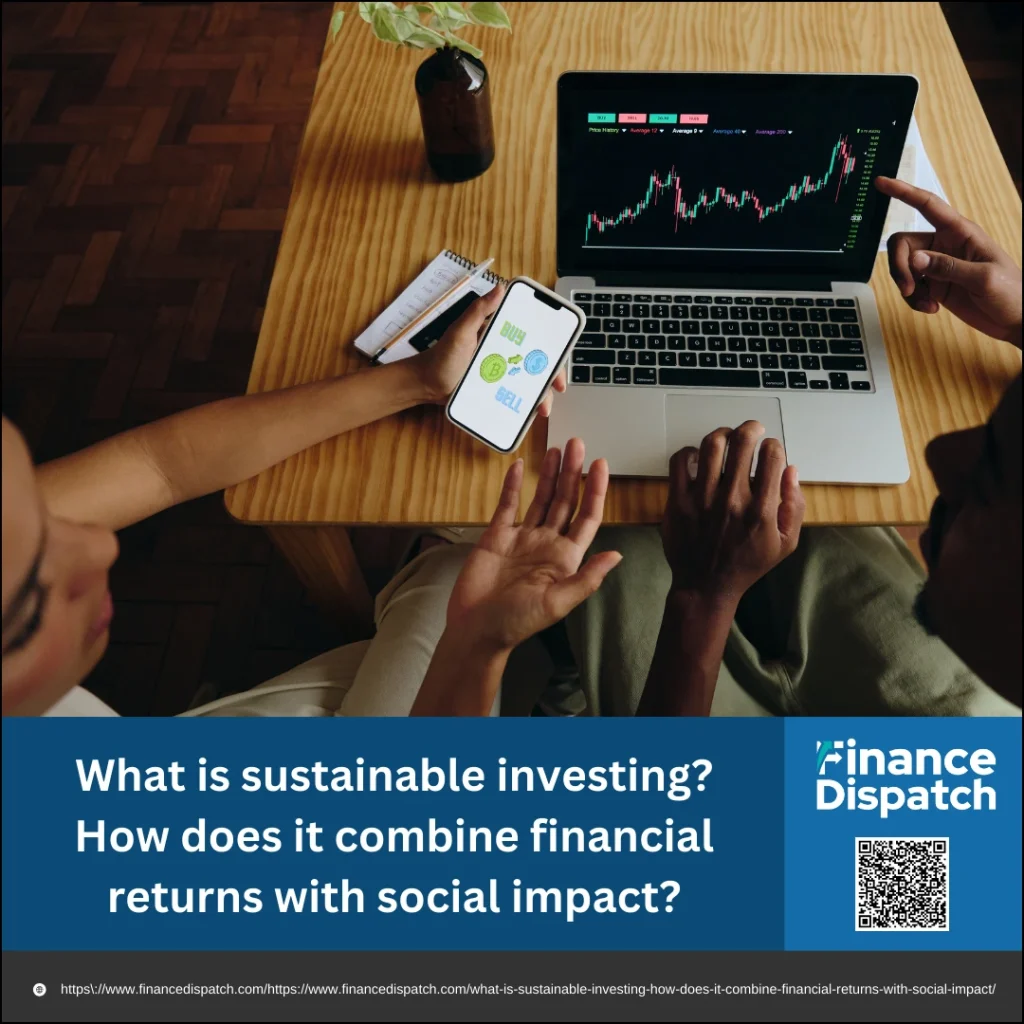In an era where global challenges like climate change, inequality, and corporate accountability are shaping financial decisions, sustainable investing has emerged as a powerful approach that aligns profit with purpose. Rather than focusing solely on financial gains, sustainable investing integrates environmental, social, and governance (ESG) criteria to evaluate long-term value and societal impact. It offers a pathway for investors to grow their wealth responsibly while supporting companies that drive positive change for people and the planet. This article explores what sustainable investing truly means—and how it effectively combines financial returns with meaningful social outcomes.
What Is Sustainable Investing?
Sustainable investing is an investment approach that seeks to generate financial returns while also promoting positive environmental, social, and governance (ESG) outcomes. Unlike traditional investing, which prioritizes short-term profit, sustainable investing takes a broader view by considering how companies operate, treat people, and impact the planet. This approach involves assessing factors such as a company’s carbon footprint, labor practices, board diversity, and ethical transparency before making investment decisions. By aligning investments with personal or institutional values, sustainable investing allows individuals to support responsible business practices while still aiming for long-term financial growth.
Key ESG Components in Sustainable Investing
At the heart of sustainable investing lies the evaluation of a company’s performance through Environmental, Social, and Governance (ESG) criteria. These three pillars offer a framework to assess how responsibly a business operates beyond just its financial metrics. By examining ESG factors, investors can better understand a company’s long-term risks and opportunities, as well as its potential for positive societal impact. Below is a table summarizing the core ESG components and examples of what each category typically includes:
| ESG Pillar | Focus Areas | Examples |
| Environmental | Company’s interaction with the natural world | Carbon emissions, renewable energy use, waste management |
| Social | Impact on people and society | Labor practices, diversity and inclusion, human rights |
| Governance | Corporate leadership and ethical standards | Board structure, executive pay, anti-corruption policies |
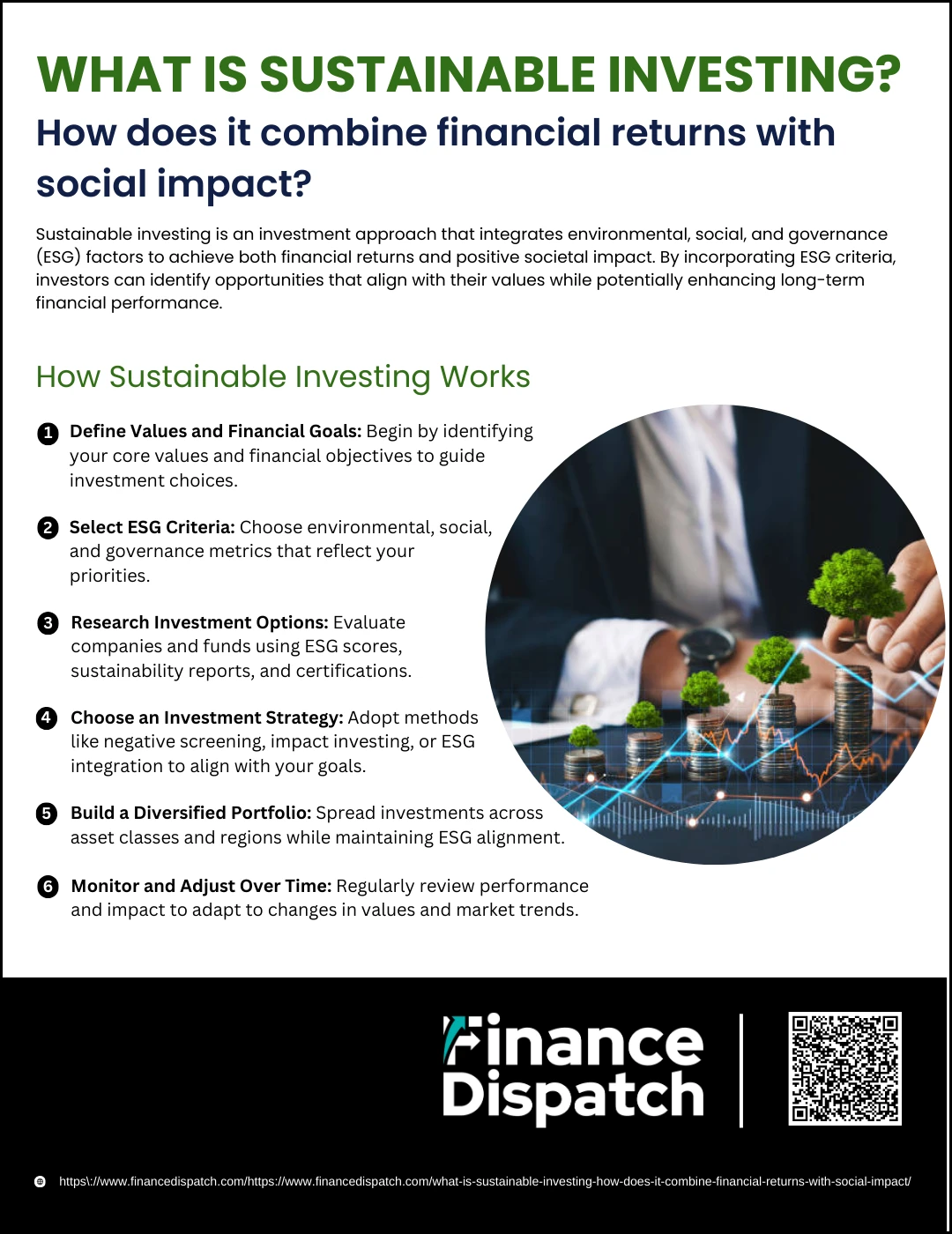 How Sustainable Investing Works
How Sustainable Investing Works
Sustainable investing works by aligning capital with companies and projects that deliver both financial performance and positive societal impact. Unlike conventional investing, which often focuses purely on maximizing returns, sustainable investing applies environmental, social, and governance (ESG) criteria to assess the overall value and risk profile of an investment. This dual approach enables investors to support ethical, forward-thinking businesses while still seeking competitive financial returns. Whether you’re an individual investor or managing a large portfolio, the process involves thoughtful steps to ensure investments reflect both your values and long-term objectives.
Here’s how sustainable investing typically works:
1. Define Values and Financial Goals
The process begins by clarifying what matters most to you—such as environmental conservation, gender equality, or ethical leadership—and determining your desired financial outcomes, whether that’s income generation, growth, or capital preservation.
2. Select ESG Criteria
Investors choose specific ESG metrics that align with their priorities. For instance, one might prioritize low carbon emissions (environmental), strong labor rights (social), or corporate transparency (governance) as part of the investment filter.
3. Research Investment Options
With ESG priorities defined, investors evaluate individual stocks, bonds, mutual funds, or ETFs using ESG scores, company sustainability reports, and certifications like B Corp, LEED, or Fair Trade to ensure alignment.
4. Choose an Investment Strategy
Investors may adopt one or more strategies:
-
- Negative screening to exclude unethical industries like tobacco or fossil fuels
- Positive screening to include top ESG performers
- Impact investing to directly fund solutions like clean energy or affordable housing
5. Build a Diversified Portfolio
A well-structured portfolio balances risk and opportunity by spreading investments across various asset classes, sectors, and geographies—all while maintaining ESG alignment.
6. Monitor and Adjust Over Time
Sustainable investing is not a one-time decision. Investors continually review both the financial performance and ESG impact of their investments, making adjustments as values evolve, new opportunities emerge, or companies improve—or decline—in sustainability.
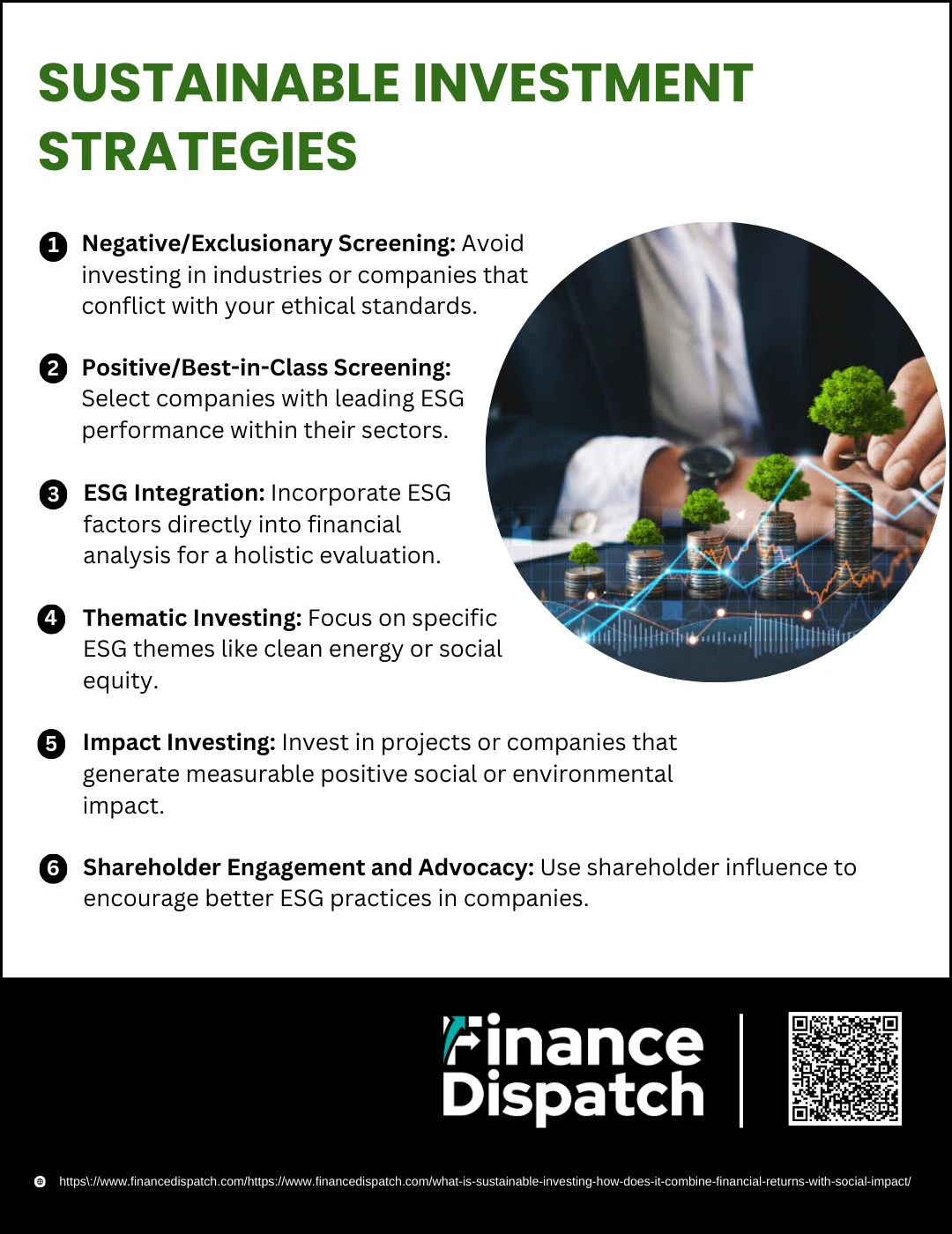 Sustainable Investment Strategies
Sustainable Investment Strategies
Sustainable investments strategies are the methods investors use to incorporate environmental, social, and governance (ESG) factors into their investment decisions. These strategies aim to generate long-term financial returns while fostering ethical, transparent, and sustainable business practices. Depending on the investor’s values, goals, and risk tolerance, different strategies can be applied individually or in combination. Some focus on avoiding harm, while others actively promote positive change. Here’s a closer look at the main sustainable investment strategies:
1. Negative/Exclusionary Screening
This traditional approach removes certain industries or companies from a portfolio based on predefined ethical or ESG criteria. For example, many investors exclude sectors such as tobacco, coal, firearms, or companies involved in human rights violations. The goal is to avoid funding activities that conflict with the investor’s moral or sustainability values.
2. Positive/Best-in-Class Screening
Rather than focusing on what to avoid, this strategy emphasizes investing in companies that outperform their peers on ESG factors. These “best-in-class” firms demonstrate leadership in areas like renewable energy use, employee welfare, or responsible governance, making them attractive for sustainability-focused investors.
3. ESG Integration
ESG integration weaves sustainability factors into the core financial analysis used to evaluate investments. Rather than treating ESG as a separate screen, it becomes part of the overall assessment of a company’s financial health, risk exposure, and growth potential. For example, a company with poor environmental practices might be seen as a financial risk due to potential regulatory fines or public backlash.
4. Thematic Investing
This strategy revolves around specific ESG-related themes or trends, such as climate change solutions, sustainable agriculture, clean water, or social equity. Investors seek opportunities that align directly with these themes, aiming to benefit from their long-term relevance and growth potential.
5. Impact Investing
Impact investing goes beyond ESG scores and seeks out investments that produce measurable, positive social or environmental results. This could include financing microloans for underserved communities, funding green infrastructure, or supporting educational initiatives. Financial return is still important—but equally crucial is the investment’s direct, tangible impact.
6. Shareholder Engagement and Advocacy
Investors can influence corporate behavior by using their shareholder rights. This includes voting on ESG issues at annual meetings or initiating dialogue with company leaders to push for better practices. For example, shareholders might advocate for more diverse board representation, transparent supply chains, or reduced carbon emissions.
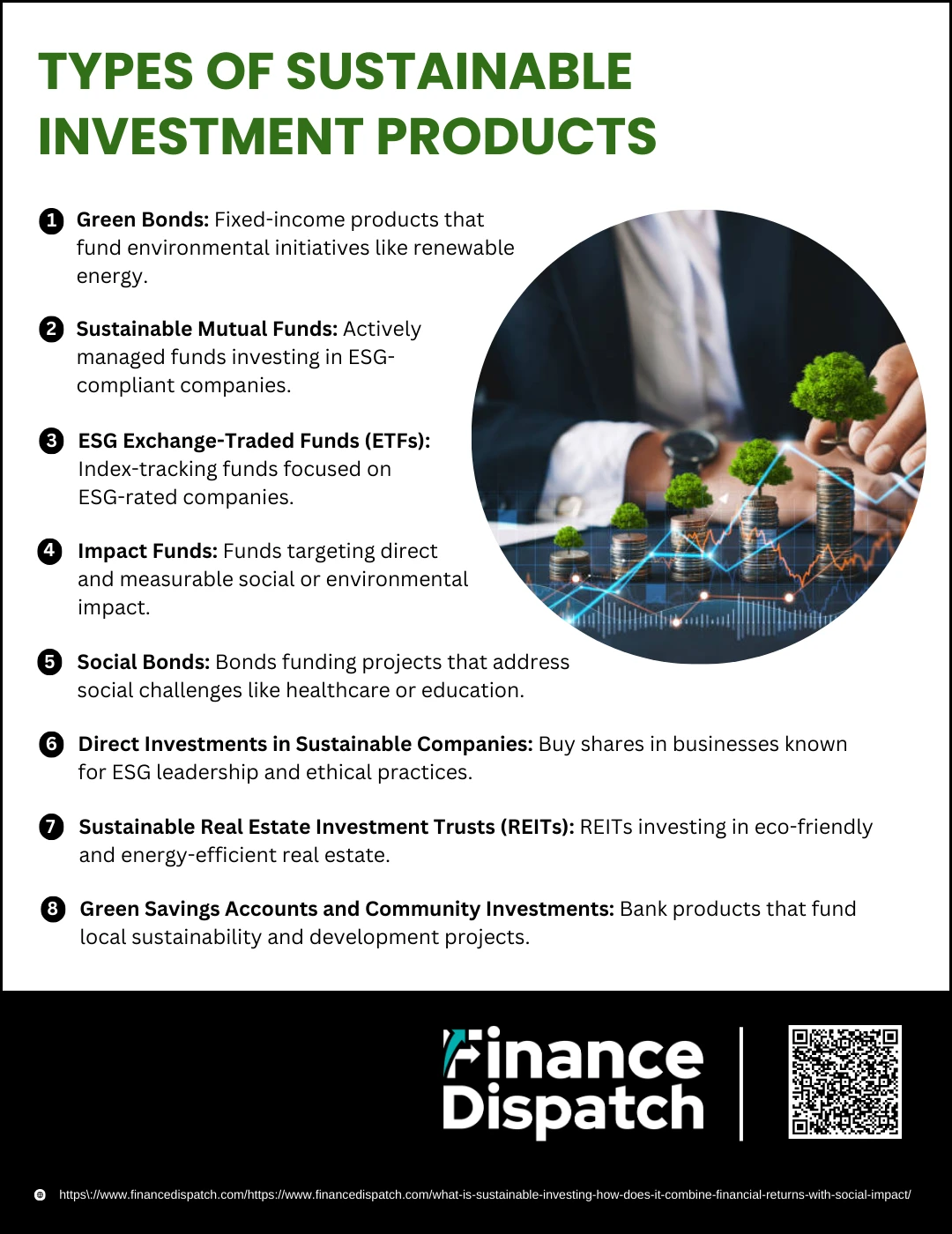 Types of Sustainable Investment Products
Types of Sustainable Investment Products
Sustainable investment products come in a variety of forms, offering investors multiple ways to align their financial portfolios with their ethical and environmental values. Whether you’re seeking stable income, long-term growth, or direct social impact, there are investment options designed to suit different risk levels and sustainability goals. These products are built around Environmental, Social, and Governance (ESG) principles and allow both individuals and institutions to support responsible and forward-thinking businesses. Below are the main types of sustainable investment products:
1. Green Bonds
Green bonds are fixed-income instruments specifically issued to fund environmental projects, such as renewable energy, clean transportation, or energy-efficient buildings. Investors earn regular interest while supporting eco-friendly initiatives.
2. Sustainable Mutual Funds
These funds pool money from multiple investors to invest in a diversified portfolio of companies that meet certain ESG criteria. They are actively managed and typically focus on firms with strong sustainability practices.
3. ESG Exchange-Traded Funds (ETFs)
ESG ETFs track indexes composed of companies screened for strong environmental, social, and governance performance. They offer diversification, lower fees, and are easily accessible through most brokerage platforms.
4. Impact Funds
Designed to achieve measurable positive social or environmental outcomes, impact funds invest in companies or projects that directly address issues such as clean water, affordable housing, or education, while also aiming for financial returns.
5. Social Bonds
Similar to green bonds, social bonds are issued to finance projects that promote positive social outcomes, such as healthcare, education, or economic inclusion in underserved communities.
6. Direct Investments in Sustainable Companies
Investors can choose to buy shares in individual companies known for their ESG leadership, such as firms in clean tech, sustainable agriculture, or ethical supply chains. This allows for targeted support of businesses that align closely with personal values.
7. Sustainable Real Estate Investment Trusts (REITs)
These REITs invest in energy-efficient, eco-certified, or low-carbon-emission real estate projects. They provide income through dividends and potential for capital appreciation while supporting green infrastructure.
8. Green Savings Accounts and Community Investments
Some banks offer savings accounts or certificates of deposit (CDs) where deposited funds are used to support sustainable loans and community development projects, such as affordable housing or renewable energy.
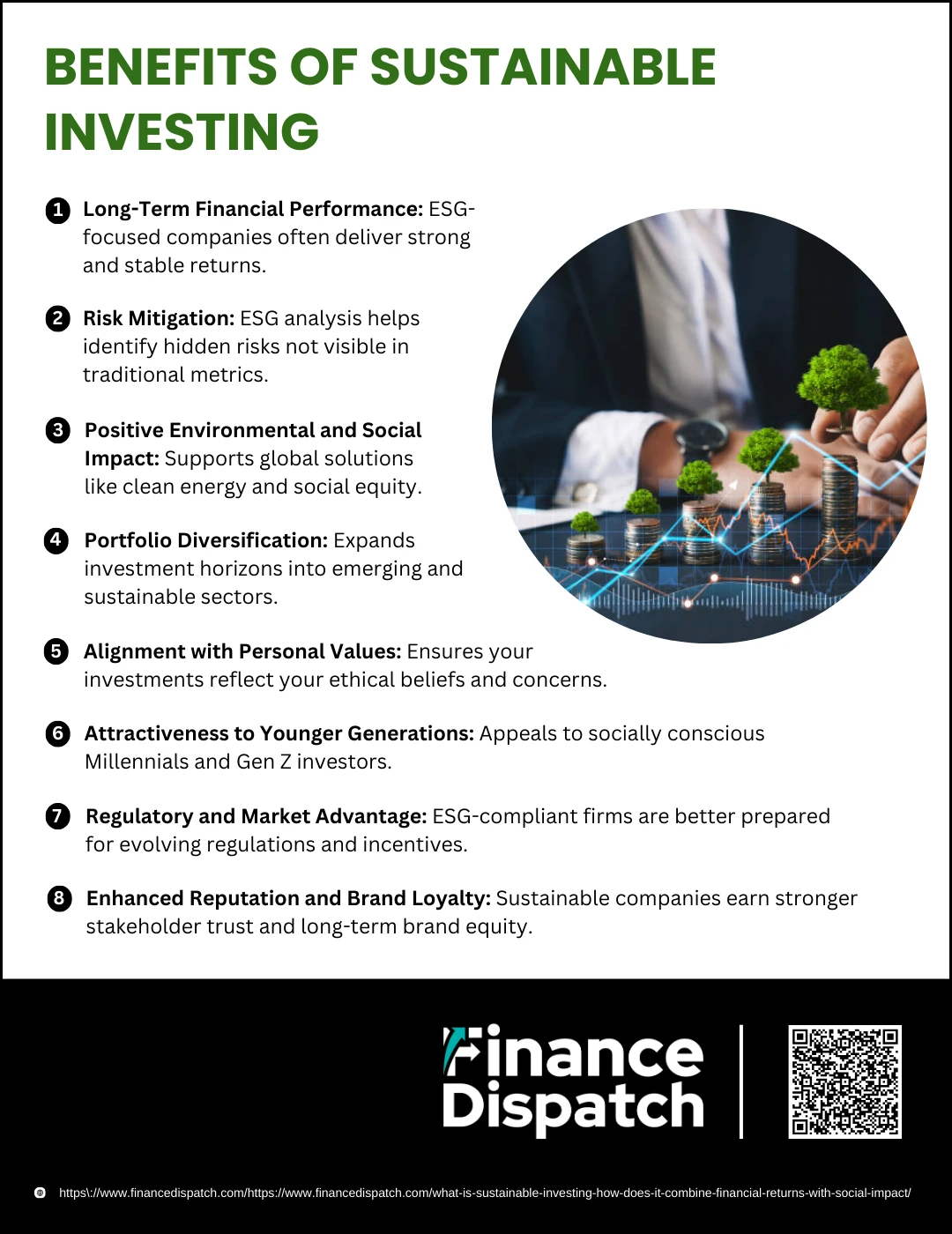 Benefits of Sustainable Investing
Benefits of Sustainable Investing
Sustainable investing is no longer just a niche strategy—it has become a mainstream approach that combines financial performance with a commitment to social and environmental progress. By evaluating investments through environmental, social, and governance (ESG) factors, investors can uncover new growth opportunities, reduce exposure to long-term risks, and support companies that are actively solving global challenges. Beyond financial gains, sustainable investing allows individuals to express their personal values and contribute to a more ethical, inclusive, and sustainable world. Below are the key benefits of this powerful investment approach:
1. Long-Term Financial Performance
Research increasingly shows that companies with strong ESG practices tend to outperform their peers over the long run. These businesses are more efficient, resilient to crises, and better prepared for regulatory changes—qualities that contribute to stable and sustainable financial returns.
2. Risk Mitigation
ESG analysis helps investors spot potential red flags that traditional financial metrics might overlook. For instance, a company with poor environmental practices may face costly legal battles or consumer backlash, while poor governance could signal future scandals. Sustainable investing helps manage these risks before they impact performance.
3. Positive Environmental and Social Impact
Sustainable investing enables your capital to support solutions to pressing issues such as climate change, poverty, or inequality. Whether through green bonds or ESG-focused funds, you can invest in initiatives that aim to reduce carbon emissions, improve labor conditions, or increase access to clean water and healthcare.
4. Portfolio Diversification
By incorporating ESG criteria, investors gain access to sectors and companies that are often overlooked by traditional portfolios—such as clean energy, sustainable agriculture, and impact-driven startups. This added layer of diversification can improve resilience and adaptability in shifting market conditions.
5. Alignment with Personal Values
Sustainable investing empowers individuals to ensure their financial decisions reflect their beliefs. For example, you can avoid supporting companies involved in fossil fuels, weapons, or unethical labor practices, and instead choose firms that prioritize equality, environmental stewardship, or corporate transparency.
6. Attractiveness to Younger Generations
Millennial and Gen Z investors are driving demand for ethical and sustainable financial products. For financial advisors and institutions, offering sustainable investing options is critical to appealing to this socially conscious generation and preparing for future wealth transfers.
7. Regulatory and Market Advantage
As governments and regulators around the world impose stricter ESG disclosure requirements, companies with strong ESG frameworks are better positioned to comply and thrive. These firms may also benefit from tax incentives, grants, and preferential treatment from sustainability-focused funds.
8. Enhanced Reputation and Brand Loyalty
Companies that practice sustainability tend to earn stronger trust from stakeholders, including customers, employees, and investors. This positive reputation can lead to better employee retention, higher customer satisfaction, and long-term competitive advantages—all of which benefit investors.
Challenges and Misconceptions about Sustainable Investing
While sustainable investing continues to grow in popularity, it is not without its hurdles. Many investors face confusion due to inconsistent ESG standards, concerns about financial performance, or misunderstandings about what sustainability truly entails. These challenges can discourage participation or lead to ineffective investment decisions. Understanding the common obstacles and myths can help investors make more informed, confident choices when aligning their values with their financial goals.
- Greenwashing: Some companies exaggerate or falsely claim to follow sustainable practices, making it hard for investors to distinguish truly responsible firms from those using sustainability as a marketing tool.
- Lack of Standardized ESG Metrics: ESG scoring systems vary widely among rating agencies, leading to inconsistent data and difficulty comparing companies across the same industry.
- Perceived Lower Returns: A common misconception is that sustainable investments underperform traditional ones. In reality, many ESG-aligned funds have shown competitive or superior returns over the long term.
- Short-Term vs. Long-Term Focus: Sustainable investments are often designed for long-term impact, which may not appeal to investors seeking quick profits or immediate performance.
- Limited Transparency: Not all companies disclose detailed ESG information, making it difficult for investors to evaluate how aligned an investment is with their sustainability criteria.
- False Assumptions about “Perfect” Companies: Investors may expect ESG-compliant companies to be flawless. In truth, sustainability is a spectrum, and even leading firms are still evolving and improving.
- Confusion between ESG, SRI, and Impact Investing: These terms are often used interchangeably, though they represent different strategies. Misunderstanding them can result in misaligned expectations or goals.
- Access and Affordability: Some investors assume sustainable investing is only for institutions or the wealthy, but affordable options like ESG ETFs and robo-advisors have made it more accessible.
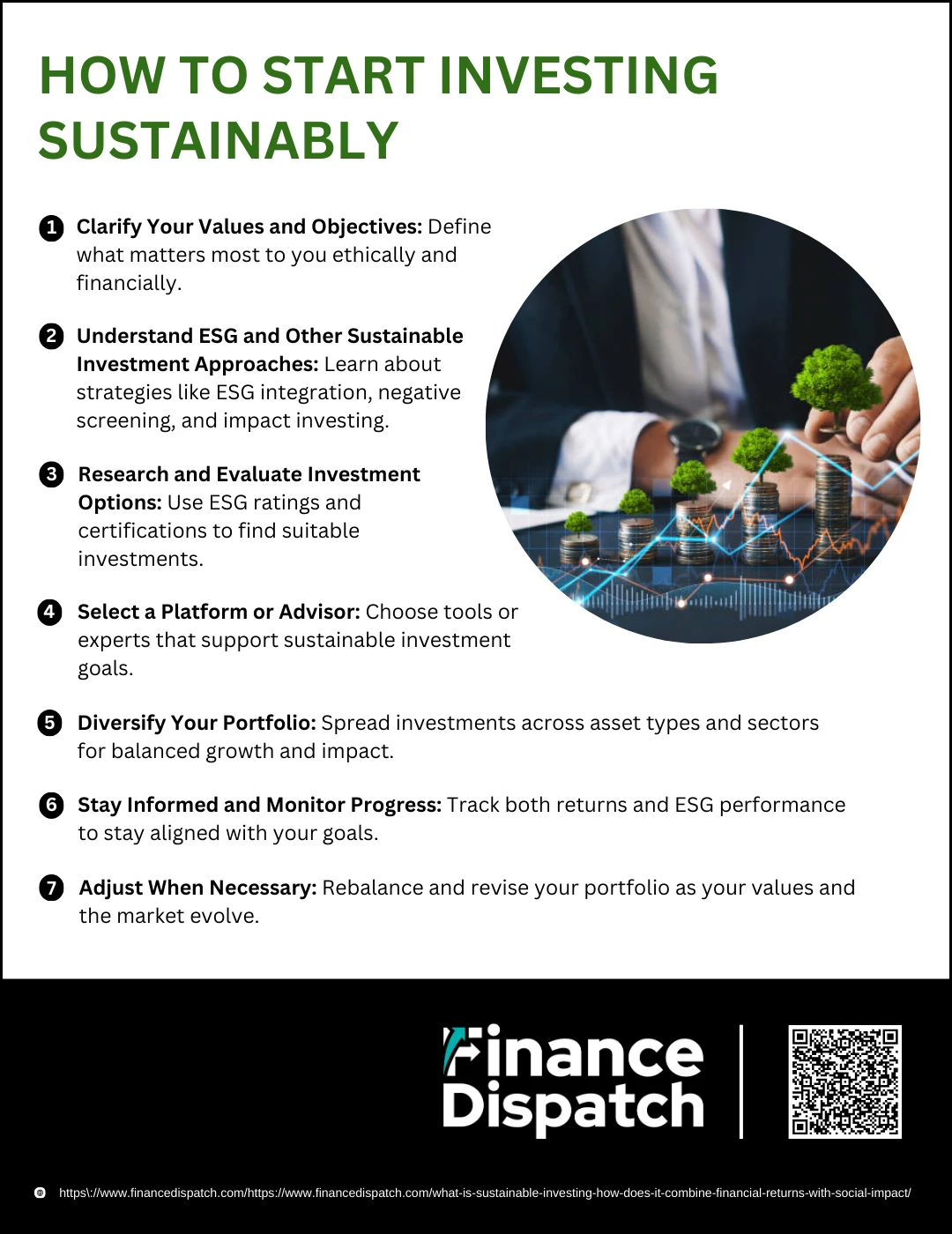 How to Start Investing Sustainably
How to Start Investing Sustainably
Sustainable investing allows individuals to align their financial decisions with their personal values, contributing to a more ethical and environmentally responsible world. Whether your concerns lie in climate change, social justice, or corporate accountability, sustainable investing offers a structured path to make a difference—without compromising on returns. The key is to take a thoughtful, informed approach that balances financial goals with your desired impact. Here’s a more detailed step-by-step guide to help you get started:
1. Clarify Your Values and Objectives
Begin by identifying the causes and values that matter most to you. Are you passionate about clean energy, reducing inequality, or corporate transparency? Then, define your financial goals—whether it’s growing your retirement savings, preserving capital, or generating income. The clearer you are on your priorities, the easier it is to align your investments with them.
2. Understand ESG and Other Sustainable Investment Approaches
Familiarize yourself with the various sustainable investing strategies:
- ESG Integration: Incorporating environmental, social, and governance factors into financial analysis.
- Negative Screening: Excluding companies or sectors that conflict with your values (e.g., tobacco or fossil fuels).
- Positive Screening/Best-in-Class: Actively choosing companies with top-tier ESG performance.
- Impact Investing: Targeting measurable social or environmental impact alongside financial return.
Knowing the differences will help you choose the right strategy for your goals.
3. Research and Evaluate Investment Options
Analyze the sustainability performance of companies or funds using ESG scores from rating agencies like MSCI or Sustainalytics. Review annual sustainability reports, corporate responsibility disclosures, and independent certifications such as B Corp, Fair Trade, or LEED. Consider investment vehicles like green bonds, ESG mutual funds, ETFs, or stocks in ethical companies.
4. Select a Platform or Advisor
Choose a brokerage that supports ESG investing with screening tools and ESG-labeled funds. Alternatively, work with a financial advisor who specializes in sustainable investing. For beginners, robo-advisors like Betterment or Wealthsimple offer pre-built ESG portfolios that simplify the process.
5. Diversify Your Portfolio
Build a diversified portfolio that reflects both your values and investment strategy. Mix assets across sectors and geographies to minimize risk while supporting a range of sustainability efforts—from renewable energy and clean water to healthcare access and responsible supply chains.
6. Stay Informed and Monitor Progress
Keep track of both financial performance and ESG impact. Follow news on sustainability trends, ESG regulations, and global economic developments that might affect your investments. Many platforms provide ESG ratings updates and sustainability news feeds to support ongoing awareness.
7. Adjust When Necessary
Sustainable investing is a dynamic process. As your personal values shift or new information emerges, you may need to rebalance your portfolio. Remove underperforming assets, add new ESG leaders, or switch strategies as needed to stay aligned with your evolving goals.
Conclusion
Sustainable investing offers a compelling path for individuals and institutions to align their financial goals with a greater purpose. By integrating environmental, social, and governance (ESG) factors into investment decisions, it enables you to pursue long-term financial returns while actively supporting ethical business practices and meaningful global change. As awareness of climate risk, social justice, and corporate responsibility continues to grow, sustainable investing is no longer just a trend—it’s a powerful movement reshaping the future of finance. Whether you’re just beginning your investment journey or refining an existing portfolio, sustainable investing empowers you to make a positive impact without sacrificing performance.



